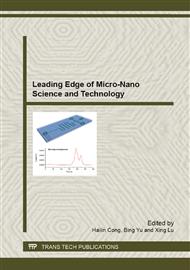p.55
p.63
p.67
p.72
p.79
p.85
p.91
p.95
p.99
Ammonia Gas Sensor Based on Aniline Reduced Graphene Oxide
Abstract:
Here we demonstrate a promising gas sensor based on aniline reduced graphene oxide (RGO), which is fabricated through drop drying RGO nanosheets suspension between the electrode arrays to create conductive networks. RGO, as the sensing materials, which is prepared via the chemical reduction of graphene oxide (GO) by aniline, has been characterized by infrared spectroscopy, UV-Vis spectroscopy, transmittance electron microscopy and scanning electron microscopy. The sensing properties of RGO have also been studied, and the results show that RGO reduced from aniline (RGO-A) exhibits an excellent response to ammonia gas (NH3). Comparing with the RGO reduced from hydrazine (RGO-H) and polyaniline (PANI) nanofiber, the RGO-A exhibits a much better response to NH3 gas. The response of the sensor based on RGO-A to 50 ppm NH3 gas exhibits about 9.2 times and 3.5 times higher than those of the device based RGO-H and PANI nanofiber respectively. In addition, the RGO-A sensor exhibits an excellent repeatability and selectivity to NH3 gas. The oxidized aniline, i.e., polyaniline, which is attached on the surface of RGO sheets through π–π interaction, plays important roles in the final sensing performance of the device, and benefits for the application of the sensor in the field of NH3 gas detection.
Info:
Periodical:
Pages:
79-84
Citation:
Online since:
March 2013
Authors:
Keywords:
Price:
Сopyright:
© 2013 Trans Tech Publications Ltd. All Rights Reserved
Share:
Citation:



